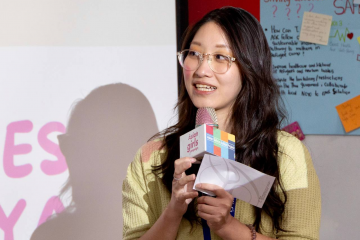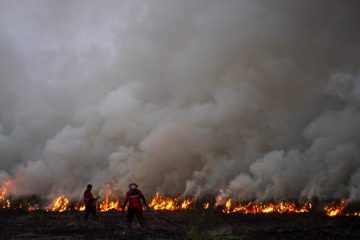The Youth Have Voted, What’s Next?
The Philippines recently concluded its midterm elections last May 12, and it is gratifying to witness how the youth sector played a vital role in the national event. According to GMA Integrated News Research, 28.79% of voters belong to Generation Z – those who were born between 1997 and 2007 – accounting for 21.87 million young Filipino voters. Their participation in the elections even contributed to a major voter turnout, prompting an unexpected shift that defied the consistent results of pre-election surveys.

The voter turnout in the said elections was described as “very high,” surpassing the Commission on Elections’ target of at least 70% of the 68 million registered voters. Ana D. Singson, spokesperson of the Parish Pastoral Council for Responsible Voting (PPCRV), shared in a press conference that they recorded an estimated 80.27% turnout – “an unlikely figure for a midterm election.”
Several analysts have linked these impressive figures to the significant increase in youth participation, as young people bring with them high hopes of helping the country reshape its system of government. As political scientist and retired University of the Philippines professor Clarita A. Carlos put it, “The young are sick and tired of the kind of politics we have,” emphasizing their growing realization that “it is their responsibility to really participate.”
And this feat is not exclusive to the Philippines, for even in other Southeast Asian countries, youth participation in elections has also proven to be significant. During the 2024 elections in Indonesia, more than half of registered voters came from the youth sector, with about 33.6% belonging to Generation Y (those born between 1981 and 1996) and 22.85% to Generation Z. In Thailand, although voter turnout in the 2025 provincial elections for council members of the Provincial Administrative Organizations was lower at 58.45% compared to the historic 75.71% recorded in the 2023 general elections, recent research still shows that Thai undergraduates consistently exercise their right to vote.
Concerns may arise regarding the motivation of young people in choosing leaders. However, considering their strong engagement in major national events, their numbers — if properly guided and maximized — can indeed be pivotal in shaping political trends, hopefully for the betterment of the entire populace.
Yet, voting is only the beginning. After the ballots have been counted and the winners of various political seats have been proclaimed, the youth’s involvement in national affairs continues. It is at this point that their roles become even more crucial. As their presence increases and their relevance grows, the way they harness their representation as a springboard for strengthening democracy makes them a vital force in nation-building.
So, what else can the youth do? Let us explore the many ways they can contribute beyond simply casting their votes.
In an age where the voices of the youth are louder and bolder, even reaching wider spaces now with their knowledge and skills in utilizing various platforms, the digital sphere in particular, their sector is no longer just ‘the future.’ They are the heartbeats of the present, and their ideas, creativity, and talents could be game-changers.
Their freedom of speech, as one of their basic democratic rights, could not just be realized on the streets, for they could utilize their own virtual spaces in expressing themselves on critical matters as significant as the elections. Their social media accounts serve as valuable channels for promoting awareness of contemporary democratic topics, trends, and advocacies such as the fight against misinformation and disinformation by verifying sources first before sharing information, correcting erroneous data, and even calling out misleading posts.

With responsibility and accountability, their presence in the digital realm can also amplify battle cries as powerfully as the voices on the streets, which could awaken the awareness of pressing issues among different sectors. One hashtag signifying social media-driven demonstrations and movements can make a relevant impact in the online world, and further, pave its translation into actual actions.
Take, for instance, the hashtag #MilkTeaAlliance, a youth-led pro-democracy movement across the Asia-Pacific region, particularly involving netizens from Hong Kong, Taiwan, Thailand, and Myanmar. It later spread to other Southeast Asian countries such as the Philippines, Indonesia, and Malaysia. This online movement began as a response to the surge of Chinese nationalist commenters on social media, eventually evolving into a vibrant transnational protest network against authoritarianism.
Similarly, the hashtags #StrikeForClimate and #FridaysForFuture, championed by young climate activists in Myanmar, Malaysia, Thailand, and the Philippines, underscored localized demands for climate justice and accountability. The active presence of youth on social media, maximizing these platforms for urgent causes, proves that they are far from apathetic to the issues confronting the region today.
Beyond raising their voices through hashtags and online movements, young people can also take proactive steps to institutionalize their advocacies. In mid-2024, Liberal Youth, a youth organization in the Philippines, joined forces with the Friedrich Naumann Foundation Philippines and BUILD Pilipinas to organize and conduct “Mastering Content Creation for Viral Success.” This was a series of digital sessions and workshops designed “to empower young content creators with the skills to counter disinformation and promote truthful, impactful digital engagement,” thereby protecting democratic discourse.
This demonstrates that, in addition to digital activism, young people can empower their democratic participation through community involvement and collaboration.
Another prime example of this is the National Youth Volunteer Program, initiated by the National Youth Commission (NYC) of the Philippines. The program now serves as an ongoing platform for training and mobilizing youth volunteers across the country, thereby allowing them to further exercise their free will in participating in opportunities for community development. Indeed, democracy’s power becomes more dynamic and influential when people from diverse backgrounds and statuses unite for a common cause.
Furthermore, the youth can also play an active role in various preventive and post-conflict operations. Whether in online or on-site settings, young people can be engaged in such initiatives, exemplifying their position as a vital sector in building and strengthening the foundations of a free, peaceful, and sustainable democracy — something many of them have already begun doing.
In the paper “Advancing Youth, Peace, and Security in Southeast Asia,” which focused on the Youth, Peace, and Security (YPS) agenda, particular instances of young people actively participating in initiatives addressing social justice and human rights were highlighted. One such example was when young people contributed to the drafting of the Bangsamoro Organic Law’s technical documentation during the Bangsamoro peace process in the Philippines. The paper also noted the establishment of the National Ethnic Youth Alliance (NEYA) in Myanmar, which was formed after more than 800 teenagers from 26 different ethnic groups attended the Ethnic Youth Conference in 2016. This alliance made recommendations for the national peace process, including giving young people a seat at the Union Peace Conference.
Moreover, as youth are increasingly entrusted with leadership and management responsibilities in schools, local governments, and other social systems, they can repeatedly demonstrate their capacity to serve as key implementers of policies as well as stakeholders in partnerships and linkages. It is therefore worth investing more in what they can contribute, especially considering that their knowledge and understanding of different forms of abuse and violence are not only derived from books, but also shaped by lived experiences and direct observations.
It is not difficult for young people to participate in, or even lead humanitarian support and outreach programs because many of them come from vulnerable and conflict-affected communities. As such, they are deeply aware of the conditions necessary for the immediate resolution and reconciliation of issues. These experiences and initiatives further attest to the remarkable influence of the youth sector in promoting human rights, addressing social injustices, and initiating actions toward freedom and harmony across cultures and societies.
The concepts and procedures needed to empower human rights, uphold social justice, promote peace, and resolve disputes for a well-structured democratic setting are already in place. Combined with the youth’s drive to act and contribute, their knowledge, skills, and competencies can have a significant impact if they are allowed to reinvent approaches and raise awareness of their vital roles in society—provided they are willing to do so.
Just as the landscapes of democracy change over time, so too must the youth’s modes of participation. Whether in virtual spaces or real-world settings, their actions must remain responsive to the needs of the people—something that becomes more possible when the youth are given the space and opportunity to engage.
In the words of Mahatma Gandhi, “If we are to reach real peace in this world, we shall have to begin with the children.” This highlights that the present generation is not wholly indifferent to the numerous issues and challenges their respective nations are currently facing, particularly in forging and fostering the foundations of a sustainable democracy. Therefore, it is crucial to keep them engaged.
The youth’s democratic participation must not be seasonal. They must embrace their role as the backbone of every nation without reservation. Their participation, in all its constructive forms, must remain omnipresent — even beyond election day.
References: BusinessWorld Online. (2025, May 14). ‘Very high’ turnout seen in polls. BusinessWorld. https://www.bworldonline.com/the-nation/2025/05/14/672555/very-high-turnout-seen-in-polls/ Fulcrum. (2025, February 20). Thai undergraduates’ voting behaviour in provincial and national elections. Fulcrum. https://fulcrum.sg/thai-undergraduates-voting-behaviour-in-provincial-and-national-elections/ GMA Integrated News. (2025, February 9). Millennials, Gen Z make up 63% of voting population. GMA News Online. https://www.gmanetwork.com/news/topstories/nation/935726/millennials-gen-z-make-up-63-of-eleksyon-2025-voters/story/ Siahaan, M. (2024, February 15). Share of registered election voters in Indonesia 2024, by generation. Statista. https://www.statista.com/statistics/1451084/indonesia-registered-2024-election-voters-by-generation/ United Nations Development Programme (UNDP). (2022). Advancing youth, peace, and security in Southeast Asia. UNDP. https://www.undp.org

About the writer
Sir Lloyd Ericson Castro Rodriguez, Teacher III Tinajero National High School – Main, Pampanga, Philippines
Currently working as a Secondary School Teacher III for twelve years, he specializes in Biological Sciences while also pursuing his passion for writing and photography. His journey in journalism began as a high school photojournalist and later as Editor-in-Chief of his university school publications. Over the years, he has honed his craft in creative writing, documentary, and environmental photojournalism, earning both national and international recognition, including being selected as a jury member for an international environmental photography award in 2024. His works have been published and exhibited in various countries, reflecting his dedication to both education and the arts. Today, he mentors young photojournalists and science writers, and facilitates training programs in these fields.



0 Comments